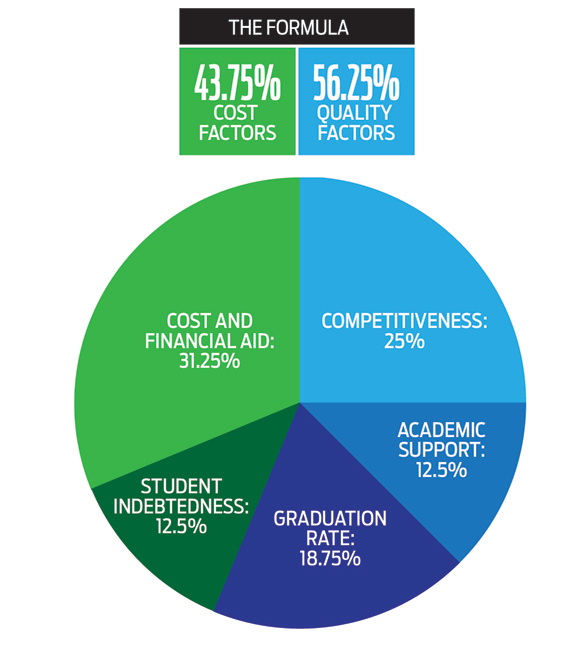How We Ranked the Top Private College Values for 2011-12
After ranking colleges and universities for more than ten years, we've tweaked our formula and our presentation for a sharper focus on our long-standing theme -- value.

After ranking colleges and universities for more than ten years, we've tweaked our formula and our presentation for a sharper focus on our long-standing theme -- value. Here's how we divvy up the criteria that determine our rankings to give you our best assessment of quality and affordability. (For a deep dive into the measure of our rankings, check out our sortable data tables.)
SEE OUR TOOL: Get Complete Rankings of Our Top 200 Private Universities and Liberal Arts Colleges
COST AND FINANCIAL AID: 31.25%
From just $107.88 $24.99 for Kiplinger Personal Finance
Become a smarter, better informed investor. Subscribe from just $107.88 $24.99, plus get up to 4 Special Issues

Sign up for Kiplinger’s Free Newsletters
Profit and prosper with the best of expert advice on investing, taxes, retirement, personal finance and more - straight to your e-mail.
Profit and prosper with the best of expert advice - straight to your e-mail.
Recognizing that every family benefits from a low sticker price, we give the most points to schools with the lowest total cost (tuition, fees, room and board, and books). We bestow points in equal measure on schools that reduce the price through need-based aid and those that knock the price down through non-need-based aid. Some schools fail to cover the gap between expected family contribution and the aid they provide. We reward schools with the highest percent of need met. To cover our bases, we give points up to the same maximum to schools based on the percent of non-need-based aid given to students.
COMPETITIVENESS: 25%
We include test scores in our formula because strong students attract other strong students, and their synergy creates an intellectual sizzle that enhances education. Admission rate, the percentage of students accepted out of those who apply, demonstrates the college's selectiveness in choosing among candidates. Because more students are applying to more schools, we added yield to our list of criteria. That number -- the percentage of students who enroll out of those who are admitted -- shows the college’s ability not only to attract strong students but also to close the deal.
ACADEMIC SUPPORT: 12.5%
Small classes, individual attention and academic mentoring contribute to student success. The students per faculty figure measures whether the college has the personnel to deliver on all three. Freshman retention rate shows the percentage of first-year students who return for sophomore year rather than dropping out or transferring. Retention rate is an important indicator of how happy students are with their education and how well the college supports them on their path to a degree.
GRADUATION RATES: 18.75%
Paying for four years of college is tough enough. Paying for five or six? Do the math and weep. Our retooled rankings give maximum weight to the four-year graduation rate to reward colleges that help students get undergraduate degrees on time and within budget. Because we know that life happens, we also give points -- albeit half as many -- to colleges with a strong showing of students who get the job done in five years.
STUDENT INDEBTEDNESS: 12.5%
As college costs rise, so does average debt at graduation, to the tune of $24,000 among all student borrowers and $28,000 for student borrowers at private colleges, according to the Project on Student Debt. We think that's a lot, so we bumped up our points to benefit colleges that keep average debt down. We also created a new category: percent of students who borrow; the lower the number, the better the score.

Profit and prosper with the best of Kiplinger's advice on investing, taxes, retirement, personal finance and much more. Delivered daily. Enter your email in the box and click Sign Me Up.

-
 10 Cheapest Places to Live in Washington
10 Cheapest Places to Live in WashingtonProperty Tax Is Washington your go-to ski destination? These counties combine no income tax with the lowest property tax bills in the state.
-
 Healthy to 100: Secrets from Countries Where Retirees Age Best
Healthy to 100: Secrets from Countries Where Retirees Age BestLongevity is a team sport, according to author Ken Stern. Here's the secret sauce for living long, healthy lives from countries like Italy and Japan.
-
 My First $1 Million: Semiretired CPA, 68, San Francisco
My First $1 Million: Semiretired CPA, 68, San FranciscoEver wonder how someone who's made a million dollars or more did it? Kiplinger's My First $1 Million series uncovers the answers.
-
 9 Types of Insurance You Probably Don't Need
9 Types of Insurance You Probably Don't NeedFinancial Planning If you're paying for these types of insurance, you may be wasting your money. Here's what you need to know.
-
 Amazon Resale: Where Amazon Prime Returns Become Your Online Bargains
Amazon Resale: Where Amazon Prime Returns Become Your Online BargainsFeature Amazon Resale products may have some imperfections, but that often leads to wildly discounted prices.
-
 Roth IRA Contribution Limits for 2026
Roth IRA Contribution Limits for 2026Roth IRAs Roth IRAs allow you to save for retirement with after-tax dollars while you're working, and then withdraw those contributions and earnings tax-free when you retire. Here's a look at 2026 limits and income-based phaseouts.
-
 Four Tips for Renting Out Your Home on Airbnb
Four Tips for Renting Out Your Home on Airbnbreal estate Here's what you should know before listing your home on Airbnb.
-
 Five Ways to a Cheap Last-Minute Vacation
Five Ways to a Cheap Last-Minute VacationTravel It is possible to pull off a cheap last-minute vacation. Here are some tips to make it happen.
-
 How Much Life Insurance Do You Need?
How Much Life Insurance Do You Need?insurance When assessing how much life insurance you need, take a systematic approach instead of relying on rules of thumb.
-
 When Does Amazon Prime Day End in October? Everything We Know, Plus the Best Deals on Samsonite, Samsung and More
When Does Amazon Prime Day End in October? Everything We Know, Plus the Best Deals on Samsonite, Samsung and MoreAmazon Prime The Amazon Prime Big Deal Days sale ends soon. Here are the key details you need to know, plus some of our favorite deals members can shop before it's over.
-
 How to Shop for Life Insurance in 3 Easy Steps
How to Shop for Life Insurance in 3 Easy Stepsinsurance Shopping for life insurance? You may be able to estimate how much you need online, but that's just the start of your search.